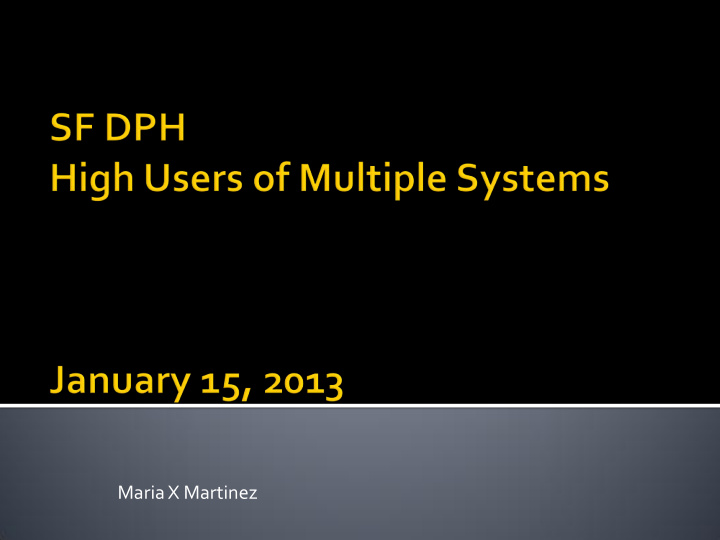



Maria X Martinez
1. Urgent/Emergent Care and challenge 2. HUMS hypothesis 3. High users, multiple systems, and multiple domains of disorders 4. Was FY 11-12 different? 5. IDS goals: 1. Targeted Street Outreach (EST) 2. Coordinated Case Management 3. Ambulatory Acuity Index
Medical System Psychiatric Sytem EMS transports PES, Dore St (PES offset) ED medical Psych Inpatient – 24hr Inpatient – 24hr Adult Diversion Units Medical Respite (hospital (hospital offset) – 24hr offset) Crisis clinics at Westside, Urgent care clinics at Mobile Crisis TWHC, hospital Substance Abuse System Sobering Center Res Medical Detox – 24hr *Programs in red are the only ones studied Res Social Detox – 24hr in other communities.
“High Users of Multiple Systems” 2007 study showed common features for high ambulance users: costly, multi-disordered, receiving care in multiple service agencies, unknown to individual systems, not sticking to any stabilizing services, and no care coordination. HUMS Hypothesis: Coordinated care, supported by integrated data, can be an effective intervention to reduce costs and improve health outcomes.
$200 million annual urgent/emergent care estimated actual costs 50,000 – 55,000 unique individuals served annually Top 1% of individuals account for 25% of costs. Top 5% account for 55% of costs.
% Summary of Total Ave Ave # FY 10-11 # Patients Total Costs Costs Cost/Pt Svcs Top 1% 511 $49,793,566 25% $97,443 89 Next 2 - 5% 2,078 $58,527,401 30% $28,165 30 Remaining 95% 49,207 $88,187,508 45% $1,792 2.5 Totals 51,796 $196,508,475 100%
Number patients in each group, FY 10-11 HUMS 312 Any 1 sys Any 2 sys All 3 sys totals Ave 175 137 Top 1% HU 199 511 Next 2-5% HU 1,009 800 269 2,078 Remaining 95% 46,344 2,654 209 49,207 47,552 3,629 615 51,796 Totals
Average Urgent Care Cost per Individual FY 10-11 HUMS Any 1 sys Any 2 sys All 3 sys totals Ave $94,375 $98,148 $101,000 Top 1% HU $97,443 Next 2 - 5% HU $27,311 $28,281 $31,028 $28,165 Remaining 95% $1,584 $4,913 $8,308 $1,792 n/a n/a n/a Totals
No, average number services per urgent care patient is same. HUMS HUMS FY 10-11 1 sys 2 sys 3 sys TotAve FY 11-12 1 sys 2 sys 3 sys TotAve Top 1% 86 90 93 89 Top 1% 85 91 92 89 Next 2 - 5% 29 30 33 30 Next 2 - 5% 28 30 33 30
Yes, average cost per patient decreased for multi-system users, but increased for single system users. HUMS HUMS FY 10-11 FY 11-12 1 sys 2 sys 3 sys TotAve 1 sys 2 sys 3 sys TotAve Top 1% Top 1% $94,375 $98,148 $101,000 $97,443 $104,365 $82,862 $57,488 $85,449 HU HU Next Next 2-5% HU $27,311 $28,281 $31,028 $28,165 2-5% HU $32,073 $21,367 $17,703 $26,498
Ambulatory Acuity Index Targeted Outreach Coordinated Case Management
Multiple Systems 1 system 2 systems 3 systems SA Psy Med SA-Med SA-Psy Psy-Med Tri Totals 44 6 125 137 Top 1% HU - 56 143 511 Multi-disorders measured by Elixhauser Co-morbidity Index 0 Diagnosis in Co-Morbidity Tri- Domains* 1 Domain Diagnosis Morbid SA- Psy- No Elix SA Psy Med Med SA-Psy Med Totals 81 63 58 232 Top 1% HU 12 5 8 52 511 * 0 Domains usually means the patient received urgent care services for acute, resolving condition; not chronic, progressive condition
30 diagnostic measurements add together to form final score. Even a single positive response predicts early mortality if untreated. All conditions are progressive without treatment. Most conditions are chronic. They can be ameliorated and stabilized with treatment. Some conditions are acute. They can be cured with treatment.
Circulatory System Endocrine System Cardiac Arrhythmias Diabetes, Uncomplicated Valvular Disease Diabetes, Complicated Congestive Heart Failure Obesity Hypertension, Uncomplic. Weight Loss Hypertension, Complic. Hypothyroidism Peripheral Vascular Dis. GenitoUrinary System Pulmonary Circulation Dis. Renal Failure Digestive System MusculoSkeletal System Liver Disease Rheumatic Arthritis / Peptic Ulcer Disease, Excl Collagen Vascular Bleeding Disease
Hematology System Cancer Deficiency Anemia Solid Tumor w/o Metastasis Blood Loss Anemia Metastatic Cancer Coagulopathy Lymphoma Fluid and Electrolyte Immune System Disorders AIDS/HIV Neurological System Psychiatric Disorders Paralysis Psychoses Other Neurological Depression Disorders Substance Use Disorders Respiratory System Alcohol Abuse Chronic Pulmonary Disease Drug Abuse
SFHOT Engagement Specialist Team Targeted street outreach with the goal of more effectively engaging and placing HUMS into care (warm handoffs and follow-up) 24-hr schedule Covers grid based upon CCMS knowledge of ambulance pickup histories Responds to 311, police, EMS for street intervention Transportation to & from urgent/emergent facilities
Current: HUMS Clinical Case Conference – monthly EST Planned: Central call-in line for EDs to consult with EST and RNs at Sobering Center (use of CCMS) Addition of electronic case coordination tools including provider communication and oversight of “community care plan” EST assist in finding patients who were engaged with case managers but have been “lost to follow - up”
HUMS + conditions are useful way to monitor high cost / high risk patients HUMS method helps plan interventions to improve health outcomes and reduce costs EST and Care Coordination changing interactions with HUMS patients Further interventions and grant applications are planned Spotlight may be reducing costs already
Recommend
More recommend